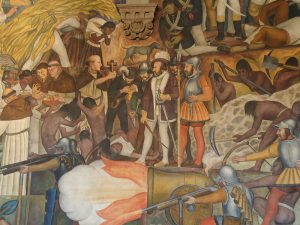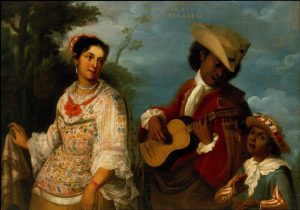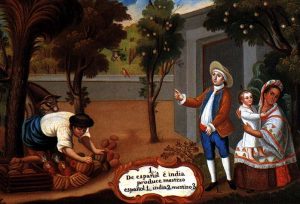Early Colonial Latin American Art

The arrival, conquest and settlement of the Spanish to the Americas set in motion the destruction of Native American civilizations. The Spanish were extremely brutal with the population and placed fierce attention on the destruction of Indigenous art forms. The destruction of Native American cultural works was noted in the writings of Spanish priests, and some were so distraught by the level of the destruction that they rescued pieces and books from being burned. For example, after the conquest of Mexico by the Spanish some of the Native population and a few priests were able to save the Codices of the Aztec Empire.
The establishment of colonial outposts or frontiers in the new territories required organizing the population that had been subdued alongside establishing new social identities for populations transplanted mainly from Africa (as slaves), but also from India and China (as ‘coolie’ indentured servants). By the 1600s colonial pictorial art had two main audiences: the first, the viewers of the work within the colonial Spanish system, the second viewer was imagined to be the colonial authorities in Spain and would-be colonial settlers/investors/and promoters of Spanish colonial rule over the entire Western Hemisphere. Keep in mind that the Spanish empire held territory from Canada, down through the Caribbean, straight down to the tip of South America; it also held colonial rule in Asia, in what is today the Philippines and Vietnam.

Colonial societies throughout Latin America required that artistic forms service the interest of colonization and within this project emerged the earliest paintings of early colonial society, the pictorial representations of the casta system.
Spanish colonialism’s casta system was a schema of racialization that produced a unique “new world” lexicon to organize bondage, social status and labor during colonial Spanish rule. Over time the system would also influence colonial settlers in the 13 colonies of the north eastern portion of North America (what would later become New York, New Jersey, Pennsylvania and the other New England States after the American Revolution. But, during the period in which the Spanish held most of North America the casta system was developed to determine legal rights and social racial status invented by the Spanish. Within the context of the Americas, race, as a social construct, was born out of the establishment of the casta system.

The logic and structure of the casta system can be analyzed via the surviving colonial portraits detailing the ordering of races. As visual guides designed to organize and instruct Spanish colonial societies, casta paintings instructed a mostly illiterate colonial settler society on the process of organizing labor along racial/casta lines. The paintings represented as many as sixteen racial categories, each with their own legal appellation, access to labor rights and predetermined states of servitude within the colonial system.

